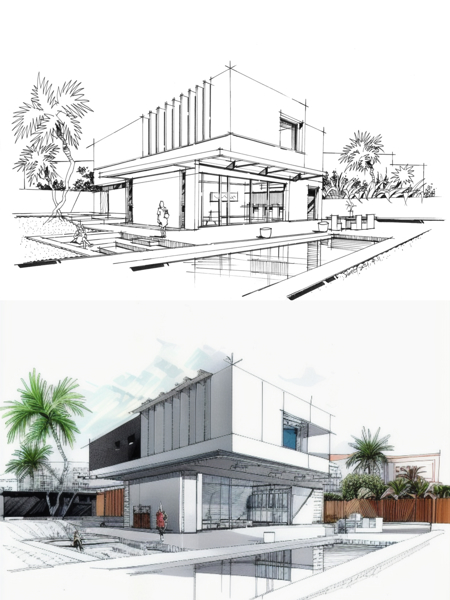Just How CDA Architects Deliver Cutting-Edge Solutions for Lasting Architecture
Just How CDA Architects Deliver Cutting-Edge Solutions for Lasting Architecture
Blog Article
A Detailed Introduction of Building Styles and Their Influence on Modern City Planning and Development
Architectural designs have actually long served as a mirror to the societal worths and technological developments of their time, playing a vital function in shaping modern-day city preparation and development. From the grandeur of Neoclassicism to the practical technique of Brutalism, each style has actually presented distinct ideas that influence city aesthetic appeals and functionality.
Historical Summary of Building Designs

As societies transitioned via the Center Ages, Gothic style arised, identified by its verticality and detailed outlining, mirroring the spiritual aspirations of the period. The Renaissance noted a resurgence of classical ideals, merging art and architecture in innovative means that influenced succeeding styles across Europe.

Today, building styles remain to advance, driven by globalization and sustainability issues, mirroring a dynamic interplay in between heritage and advancement. This historical summary underscores the value of architecture as a mirror of societal evolution and as a driver for city development.
Secret Architectural Styles Explained
The variety of architectural designs reflects the myriad influences that form our constructed environment, each personifying unique features and social significances. Secret building designs consist of Timeless, Gothic, Baroque, Modernism, and Postmodernism, each representing special historic contexts and visual philosophies.
Classical architecture, rooted in ancient Greece and Rome, highlights proportion, percentage, and the usage of columns (cda architects). In contrast, Gothic architecture, thriving between Ages, is defined by sharp arcs, ribbed safes, and flying buttresses, developing a heavenly quality in cathedrals. Baroque architecture, emerging in the 17th century, is marked by splendour, elaborate embellishment, and a vibrant interaction of light and darkness
Innovation, which acquired energy in the very early 20th century, prioritizes feature over form, making use of new materials like steel and glass to develop minimal structures. Postmodernism, reacting versus the austerity of Modernism, accepts eclecticism and historical reference, usually including spirited components and irony.

Influence on Urban Preparation
In forming the advancement of cities, architectural styles dramatically affect metropolitan preparation choices. The selection of architectural design frequently dictates the aesthetics, performance, and general character of city atmospheres. Innovation, with its emphasis on minimalism and performance, encourages open rooms and the assimilation of technology, shaping city formats that prioritize performance and ease of access. Alternatively, standard styles may stress historical preservation, bring about city layouts that keep social heritage and promote pedestrian-friendly settings.
In addition, architectural styles can affect zoning policies and land utilize plans. Urban organizers must think about the prevailing building trends when designing districts, guaranteeing that brand-new growths harmonize with existing structures. This factor to consider cultivates natural metropolitan landscapes and enhances community identification.
The implementation of certain building styles can likewise influence socioeconomic factors within a city. As an example, high-end modern designs might draw in wealthy locals and businesses, bring about gentrification, while extra inexpensive housing options could prioritize practical and sustainable layouts to accommodate diverse populaces. Eventually, the interplay in between building styles and urban planning creates vibrant cities that mirror both historic context and contemporary needs, shaping the lived experiences of their citizens
Sustainability and Modern Design
Building designs play an additional info essential role in addressing contemporary challenges, specifically in the world of sustainability. As city locations increase and ecological worries increase, modern-day style increasingly embraces lasting style principles that prioritize energy performance, source conservation, and marginal ecological influence.
Contemporary architectural motions, such as biophilic layout and eco-friendly style, advocate for structures that balance with their environments, utilizing natural products and promoting biodiversity. These styles usually incorporate renewable resource sources, such as photovoltaic panels and wind generators, to decrease dependence on fossil gas and reduced carbon impacts.
Furthermore, the combination of advanced modern technologies, such as click here to find out more wise structure systems, enhances energy administration, optimizing source usage while guaranteeing resident convenience. Cutting-edge water administration techniques, including rain harvesting and greywater recycling, further add to lasting city settings.
Notably, sustainability expands beyond environmental problems; it includes social and economic dimensions. By promoting community wellness and promoting inclusivity, modern architectural styles straighten with lasting growth goals. The evolution of building techniques continues to shape resistant cities that not just satisfy the demands of the present but likewise safeguard the future for generations to come.
Area Involvement in Style
Neighborhood engagement in style functions as an important bridge in between engineers and the populaces they serve, ensuring that the built atmosphere reflects the demands and aspirations of its individuals. This collective procedure welcomes neighborhood participants to contribute their insights and preferences, cultivating a feeling of possession and duty towards the rooms they populate.
Effective community engagement employs various techniques, such as workshops, surveys, and public online forums, to gather varied perspectives. These strategies promote a two-way dialogue, permitting engineers to recognize local contexts while equipping locals to articulate their problems and wishes. This inclusivity not only boosts the design top quality yet additionally promotes social equity by attending to the distinct challenges faced by marginalized teams.
In addition, neighborhood involvement can cause ingenious services that may not arise in a standard style process. By integrating neighborhood understanding and cultural values, designers can create rooms that resonate even more deeply with customers, improving usability and directory sustainability. Inevitably, prioritizing neighborhood interaction in style procedures causes settings that support social communications, support well-being, and strengthen neighborhood connections, thus playing an essential duty in forming contemporary metropolitan landscapes.
Verdict
Architectural styles have actually exceptionally affected contemporary city preparation and development, showing advancing social and technological contexts. As cities continue to grow and adapt, the recurring dialogue in between architectural heritage and modern-day design concepts will continue to be necessary in developing inclusive, vivid areas that improve quality of life and advertise social equity.
Report this page